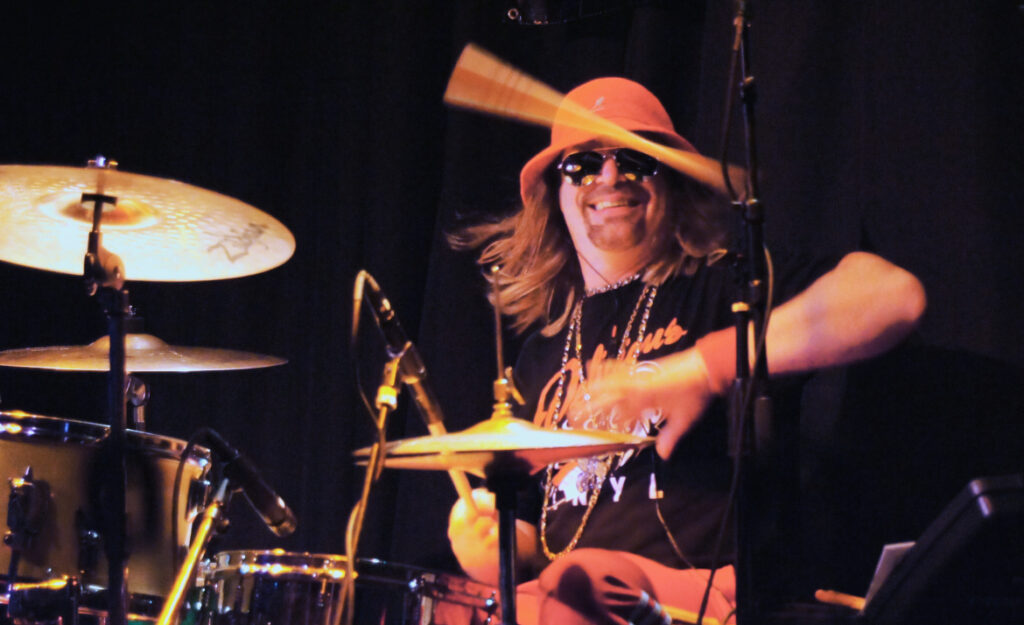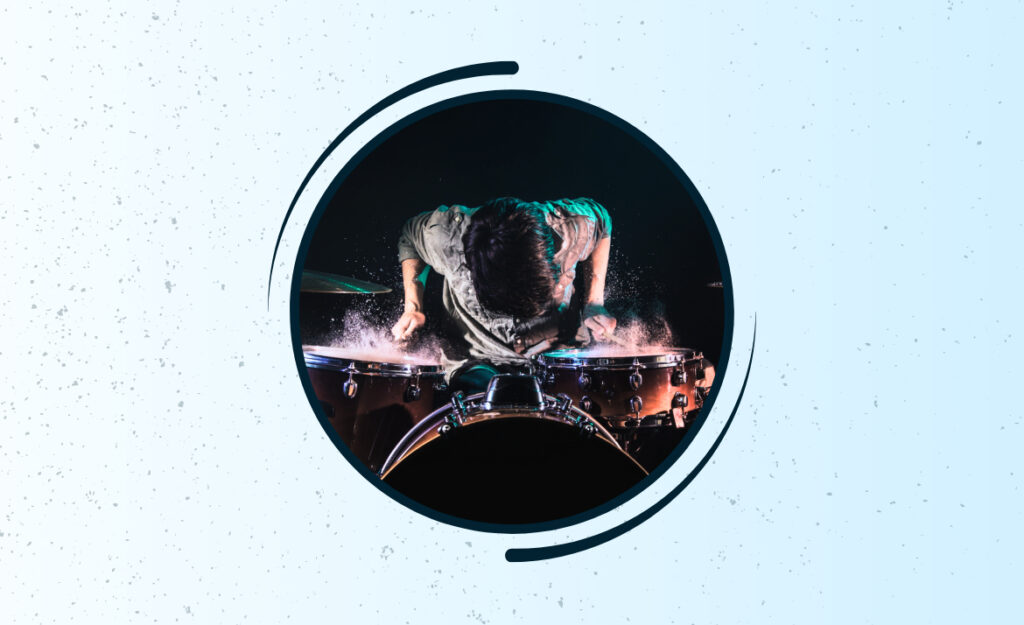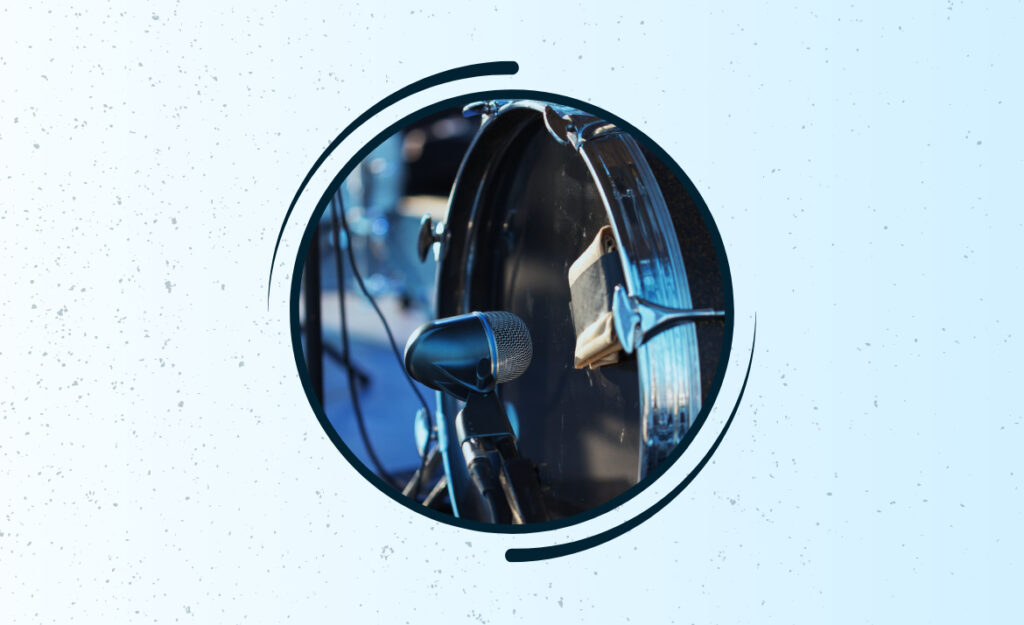Locking eyes with a crowd from behind the drum kit can feel both thrilling and intimidating. Still, effective stage presence tips give drummers the power to light up any venue, big or small.
Mastering presence as a drummer transforms routine live shows into electric, memorable experiences for listeners. The energy you project ripples out, charging the whole room and boosting your band’s overall performance.
Explore the strategies in this guide to discover real, actionable ways to connect, energize, and be remembered with every live set. These approaches fit any skill level.

Command Attention the Moment You Step Onstage
The instant you step onto the stage, fans and bandmates take their first cues from you. Purposeful movement and quick setup are crucial for giving off confidence before the first note.
Set your drums deliberately, flashing a welcoming smile or a nod at fans directly in sight lines. These gestures serve as a silent countdown and focus the audience’s anticipation on you.
Signal Readiness with Immediate, Positive Actions
Move confidently to your seat, sweeping your gaze evenly across the crowd for a moment. It’s like greeting every seat with a silent “let’s do this” before you even sit.
Set up your sticks methodically and take a controlled breath—your calm helps the room settle, even before the music. Tap the snare lightly as a soundcheck gesture and glance at your band.
Making simple, deliberate movements acts as an unspoken cue for everyone: “Get ready—something memorable is about to happen.” The audience mirrors your focused energy almost instantly.
Start Each Performance with a Signature Cue
A short stick flourish, a catchy click-off phrase, or hitting your sticks together twice both grabs attention and triggers anticipation. Many drummers announce with body language before playing.
Consider a personal ritual—tossing a drumstick in the air and catching it, or standing and giving a small wave. These easy actions work both as warmups and energy signals.
Using a signature cue at show open creates a memorable “calling card” effect, reinforcing your style and building anticipation—people pay a bit more attention every time you start this way.
| Cue Type | Visual Impact | Audience Reaction | When To Use | Next Step |
|---|---|---|---|---|
| Stick Spin | High | Immediate excitement | Just before opening hit | Practice speed at home |
| Fist Pump | Medium | Fans cheer/clap | After tuner check | Try in front of friends first |
| Quick Bow | Medium | Respectful silence | Pre-first song | Emulate favorite drummers |
| Eye Contact Sweep | Subtle | Creates tension | Drum build-up | Add to tempo count-in |
| Shout Phrase | High | Group shout-back | Before a crowd-favorite | Choose a phrase you love |
Use Body Language That Reinforces Musical Energy
A drummer’s posture, head movement, and facial expressions amplify the impact of each beat. These signals show you’re locked in and broadcasting that excitement without needing words.
Adjusting your posture to sit tall and loose with shoulders back increases both physical stamina and approachable presence on stage. Think of it as “wearing” the groove for the crowd to see.

Live Drum Dynamics: Real-World Steps for Better Balance
Learn the keys to volume control, gear tweaks, and group communication for clearer, more energetic performances.Sync Head and Shoulder Movements to Each Groove
When playing heavy parts, nodding in rhythm and leaning slightly into big fills shows emotional investment. It’s like dancing with your own instrument and inviting the audience to join you.
- Lean slightly into fills: Adds visual punch, emphasizing important transitions so crowd members track song changes more closely.
- Synchronize head bobs with the backbeat: Reinforces groove, helping the crowd feel the tempo stronger even at high volume gigs.
- Smile or react to band solos: Gives positive feedback to the music, making the stage environment vibrant and encouraging more interaction between all players.
- Relax between sections: Introducing micro-pauses after busy grooves demonstrates control, increasing listeners’ anticipation for the next section.
- Open arms wider during cymbal crashes: Signals song climaxes, creating bigger live moments with clear visual cues for photographers and fans alike.
Each gesture is a deliberate choice, gradually building your distinctive performer signature. Try combining two expressions for the next show’s opener and watch fan engagement increase.
Experiment with Facial Expression Scripts
If you’re halfway through a set, catch the bassist’s eye and flash a wide grin. This expression naturally spreads and makes both players visibly relaxed and relatable to the audience.
- Eyebrow raise on challenging fills: Highlights skill, gives attentive crowd members a mini story to enjoy for each technical turn.
- Quick smirk after playful mistakes: Turns errors into charm, setting a forgiving tone that encourages fans to root for your recovery.
- Lips pursed in focus for grooves: Underscores intensity, and draws audience into the moment as they see you invested in every beat.
- Sync mouth movements with chorus lines: Shows you know every part, prompting crowd singalongs and reinforcing band unity from the backline.
- Share a big, blink-and-you-miss-it wink toward frequent fans: Makes habitual showgoers feel seen and included, boosting loyalty over time.
Over time, mixing these small interactions with core stage presence tips creates a style that’s both unique and crowd-friendly—experiment with what feels authentic and note what earns the best reactions.
Expand Drummer-Audience Connection Through Micro-Interactions
Picking a few audience members to direct attention toward during the set fosters connection. Choose spots in the room—left, right, center—and check in at musical highlights or key song breaks.
Long halls or large stages? Adjust the frequency and direction of your gaze so each section feels included. This approach counters distance by “breaking the invisible wall” from behind the kit.
Adopt an Interaction Sequence Across a Typical Set
1. At the first downbeat, grin and nod toward the back of the crowd—the folks furthest away feel instantly included.
2. At every chorus, glance and gesture at musicians to your left and right, sidehead fans see teamwork in every transition.
3. Finish solos or breakdowns by briefly looking out and raising your sticks—this non-verbal “thank you” boosts audience energy for each new section that follows.
Add Quick, Repeatable Gestures for Signature Style
Pick a move you can repeat every show without overdoing it—like spinning a stick after every second chorus or holding up one hand at the end of your favorite track.
A drummer who always salutes the lighting operator with a raised stick gets remembered by crew and fans. It anchors your stage persona with regular, meaningful cues that crowd members start to expect.
This signature move strategy works best paired with consistent eye contact and upbeat posture, making your presence memorable beyond musical precision alone. Stage presence tips like these rapidly become habits with intentional practice.
Energize Sets with Dynamic Setlist Choices
Strategic setlist building breathes life into performances. Fast, high-energy openers draw immediate crowd interest, while surprises—like drum features or sudden breakdowns—keep audiences invested well into the set’s end.
Create your own “rollercoaster” by alternating driving up-tempo tracks with groovy, head-bobbing numbers. This pattern coordinates naturally with the physical side of stage presence, giving visual cues between songs.
Curate Transitions for Maximum Impact
After a slow intro, jump into your most energetic track to grab attention. Alternately, follow a high-energy piece with a conversational pause or story, then bring the crowd back with an unexpected drum solo.
If the band decides on a spontaneous song swap, let your body language shift with the mood—leaning in for intensity or relaxing your shoulders to cue a more mellow piece.
Chart the emotional flow ahead of time, discussing transitions in rehearsal. Everyone benefits when the energy map matches the music: all eyes on you for cues on what comes next.
Highlight Standout Moments with Mini-Story Cues
Let’s say you close the first set with an intricate fill sequence you call the “helix.” Before launching it, flash a quick index finger swirl over your head, signaling to friends, “it’s helix time!”
Fans start expecting this, and photographers ready their cameras. This story-driven cue connects the dots between technical skill and live showmanship—exactly the sort of stage presence tips that create legends.
Troubleshoot weak energy sections by pinpointing a cue or prop—a sudden splash cymbal hit or synchronized band lean—then build anticipation and pay off with visual flair on the next chorus drop.
Create Visual Impact with Drumming Accessories and Lighting Choices
Simple prop and lighting tweaks change how impactful your playing feels live. Choose colored sticks or tape to enhance visibility, or time key fills with onstage lighting changes for extra drama.
Bring a small towel with your favorite logo and use it between tracks—fans notice props used consistently, subconsciously linking them to positive show memories.
Pair Fills with Lighting for Maximum Drama
Work with your lighting tech so big snare or tom sections hit in sync with bold light flashes. For example, a burst of red during your heaviest groove, or a swirling spotlight when trading solos.
Practice your show at rehearsal with make-shift lighting to guide your body language. “On the next fill, I’ll look up and the lights go white!” Try it live and tweak for next time.
Matching dynamic playing with visual effects heightens every impact moment, making even static beats feel kinetic. You don’t need a big budget: stick to one or two effects and perfect the timing for strong delivery.
| Accessory | Usage Tip | Visual Impact | Showtime Application |
|---|---|---|---|
| Colored Drumsticks | Choose bright shades for visibility | High; easy to spot during fast fills | Rolls or solo breaks |
| Logo Towel | Wipe sweat as ritual between tracks | Medium; creates brand associations | Track breaks or close of set |
| Glow Tape | Wrap sticks or rims for dark stages | High; adds novelty effect | Night shows or dramatic fills |
| Hats/Headbands | Keep hair back, add character | Medium; changes silhouette | Breakfast gigs, festivals |
| Wristbands | Reduce sweat, coordinate with kit | Low; subtle polish | Sporty performance settings |
Stay Engaged Throughout the Set With Real-Time Feedback
Continuous engagement matters—make quick, friendly eye contact during rests, throw a thumbs up, or acknowledge inside jokes or shouts from musicians or loyal fans on cue.
Between songs, briefly nod toward specific clapping audience members or mimic their energy by drumming along with their rhythm—creating a responsive feedback loop and keeping everyone involved.

Practice Responsive Micro-Interactions in Real Stage Scenarios
Your bassist jokes “take it away!”—lean into a quick, unexpected fill then shoot a playful glance at the crowd. These moments spark real joy and promote authenticity over rehearsed performance alone.
When you spot someone singing along, match their groove by subtly exaggerating your playing in sync with the song’s key repetitive phrase. This deepens connection and celebrates community between artist and fan.
- Acknowledge band jokes with timely fills: Shows listeners you’re present and enjoying the set.
- Respond to crowd hand motions: When a fan air-drums, nod or copy the gesture, giving them an onstage shout-out.
- Match student’s excitement at clinic shows: Use staged call-and-response, repeating their simple rhythms for a fantastic participatory moment.
- Coordinate sudden stops with synchronized gestures: Heightens drama, ensuring listeners remember every transition.
- Incorporate classic drum memes or shout-outs mid-set: Creates instantly recognizable fun and relatability—say, mimicking an iconic fill before your band’s signature track.
Practicing these situational responses in rehearsal makes real shows feel spontaneous and personal. Audiences value stage presence tips that blend creativity and direct attention—giving every moment purpose and meaning.



